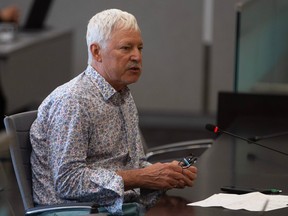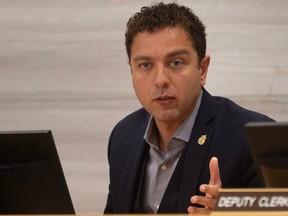Breadcrumb Trail Links
Local News
Article content
After more than two decades spent contemplating bike lanes on a heavily travelled Windsor corridor, and with the assurance that cyclists will eventually have an alternate route to traverse, a committee of city council has accepted the Wyandotte Street East road diet’s death.
On Wednesday, the city’s top engineer told the environment, transportation, and public safety committee that municipal staff have never recommended slimming down Wyandotte, despite having been asked to explore the option by council multiple times over many years.
Advertisement 2
Article content
But area cyclists still spoke out in favour of some form of bike infrastructure on the popular east/west roadway.
“I don’t support doing nothing and continuously kicking the can further down the road,” said Wayne Lessard. He told the committee he cycles about 200 kilometres each week, often in other cities and countries.
“I’m saddened when I return to the City of Windsor and see the state of the cycling infrastructure here.”
Lessard said he wants to see bike lanes along Wyandotte Street East, even if they’re painted lines instead of fully protected tracks — a preferred option among cyclists.
“When I’m riding, oftentimes I get yelled at and squeezed over to the side of the road, because people don’t recognize that legitimacy of me to be able to use that piece of road,” Lessard said. “With lines on the road, at least that indicates to drivers this is a place where cyclists can be.”

A staff report to the committee said adding bike lanes from Watson Avenue westward to Devonshire Road would require slimming down the roadway, which administration does not recommend given current vehicle volumes.
Advertisement 3
Article content
A road diet is a reduction in the number of travel lanes for vehicles on a street, and a reallocation of preserved width for other purposes, such as cycling infrastructure, turning lanes, on-street parking, pedestrian space, and green space.
The staff report also said losing street parking is something business groups oppose. In previous presentations to the city, however, local business improvement associations advocated for reduced lanes to help address a “dangerous situation” of high volumes of speeding traffic whipping through their commercial areas.
Road diets have been shown to reduce speeding and the severity and frequency of collisions. They can also encourage cycling and increase separation between traffic and pedestrians.
Painted bike lanes installed along Wyandotte between Devonshire Road and Glengarry Avenue between 2013 and 2014 further to the west did not include a road diet, nor was parking removed. But the staff report said those bike lanes “no longer meet the recommendations in the revised Ontario Traffic Manual” and won’t be replicated on similarly high-traffic roads.
Advertisement 4
Article content
“The only facility that meets the recommendations for an arterial road servicing the volume of traffic currently being realized is fully protected and/or off road facilities,” the report said.
Street-protected bike lanes, it said, “are not possible in many locations throughout the corridor without significant reconstruction and/or removal of parking.”

To satisfy the city’s Active Transportation Master Plan, staff instead recommend installing cycling infrastructure along Riverside Drive’s 16 km stretch as part of the Riverside Drive Vista Improvement Project. That project began modestly in 2010 with intersection work at Crawford Avenue and has since seen upgrades from Riverdale Avenue to Lauzon Road, including bike lanes.
The committee was asked to receive the staff report as information, meaning it did not need to make any decisions or provide direction for action.
Committee chair and Ward 2 Coun. Fabio Costante voted against receiving the report out of concern for the precedent it sets: precluding bike lane installation on similarly busy roads in commercial districts.
Advertisement 5
Article content
“It’s a small stretch (of Wyandotte), but at the root of this, it really is a culture change in our city,” Costante said.
“We know that any city that is mid- to large-size in North America has to have connected cycling infrastructure. It has to.”

Windsor Mayor Drew Dilkens broke the news of the road diet’s apparent impossibility during 2024 budget deliberations in January. He told his council colleagues the street would “fail” if slimmed, a message he received from city engineers.
As a result, Dilkens proposed an amendment to this year’s mayoral budget: halt road diet talks and take $225,000 from the budget stabilization reserve to install crosswalks along a stretch of Wyandotte Street East through Riverside that was in need of traffic calming. Council went along with the amendment.
Nearly a month later, however, the road diet issue caused a stir at city council. Ward 9 Coun. Kieran McKenzie publicly took issue with the project’s hasty demise and questioned why council killed the road diet and allocated funding for crosswalks in one fell swoop, when city staff had yet to complete a report about the major corridor’s proposed narrowing. That report was presented to the council committee this week.
Advertisement 6
Article content
Look at other communities — we’re way behind
“This is the final nail in the Wyandotte Street bike lane project. This is it,” McKenzie said Wednesday.
“There’s people in the community who are frustrated about our lack of progress on moving forward with active transportation infrastructure and a network that makes sense. We shouldn’t blame them.
“They have every right to be frustrated — I am frustrated. If we look at other communities, we’re way behind.”

While staff have looked into narrowing Wyandotte Street East several times over a number of years, acting city engineer Mark Winterton said administration has never advised council to remove traffic lanes.
“This has been brought back a couple of times, but administration’s position has never changed,” Winterton said. “Although we were directed (by council) to put in some level of active transportation, we have never recommended the removal of parking and/or traffic lanes.”
Alternatively, Winterton said, staff have consistently recommended Riverside Drive as an east/west route for cyclists. He acknowledged that the installation of bike lanes — part of the Riverside Drive Vista Improvement Project — is taking “much longer than we had anticipated” and highlighted project delays stemming from major east Windsor flood events in 2016 and 2017.
Advertisement 7
Article content
Progressive cities understand
The Riverside Drive Vista Improvement Project will, once complete, extend 16 km along the waterfront from the municipal border with Tecumseh in the east to Rosedale Avenue just west of the Ambassador Bridge. The project will see Riverside Drive widened with painted bike lanes added to the asphalt driving surface.
The next phase of the Riverside Vista project encapsulates part of the section of Riverside Drive between St. Rose Avenue and Ford Boulevard. Construction on that phase is expected to begin in 2026.
Diana Furlong, a Windsor cyclist, implored the committee to reconsider ditching the Wyandotte road diet.
“As I get older, it often feels nearly irresponsible to risk my own safety riding unprotected on Wyandotte Street East,” Furlong said.
“It’s frustrating as a cyclist to try to make a plan to get safely and efficiently from point A to point B in this city, where bicycle lanes end abruptly or connect through areas that add much greater distance to a commute.”
Recommended from Editorial

Windsor ‘road diet’ project dead in the water … for now

What Windsor council changed in the mayor’s 2024 budget

Planners, engineers look at going Dutch on local roads

Narrowing Wyandotte to two lanes in Riverside ‘would benefit everybody’
Advertisement 8
Article content
A letter to the committee from Lori Newton, executive director of Bike Windsor Essex and the Bike Kitchen, called the report a “bait and switch” after more than two decades of discussions and studies about bike lanes on Wyandotte Street East. In 2001, city council ratified the Bicycle Use Master Plan, which called for bike lanes along the entire stretch of Wyandotte Street.
“Progressive cities understand induced demand and recognize that sacrificing equity and safety on the road so that car drivers save seconds during ‘rush hour’ is no longer acceptable,” Newton said.
tcampbell@postmedia.com
twitter.com/wstarcampbell
Article content
Share this article in your social network




















